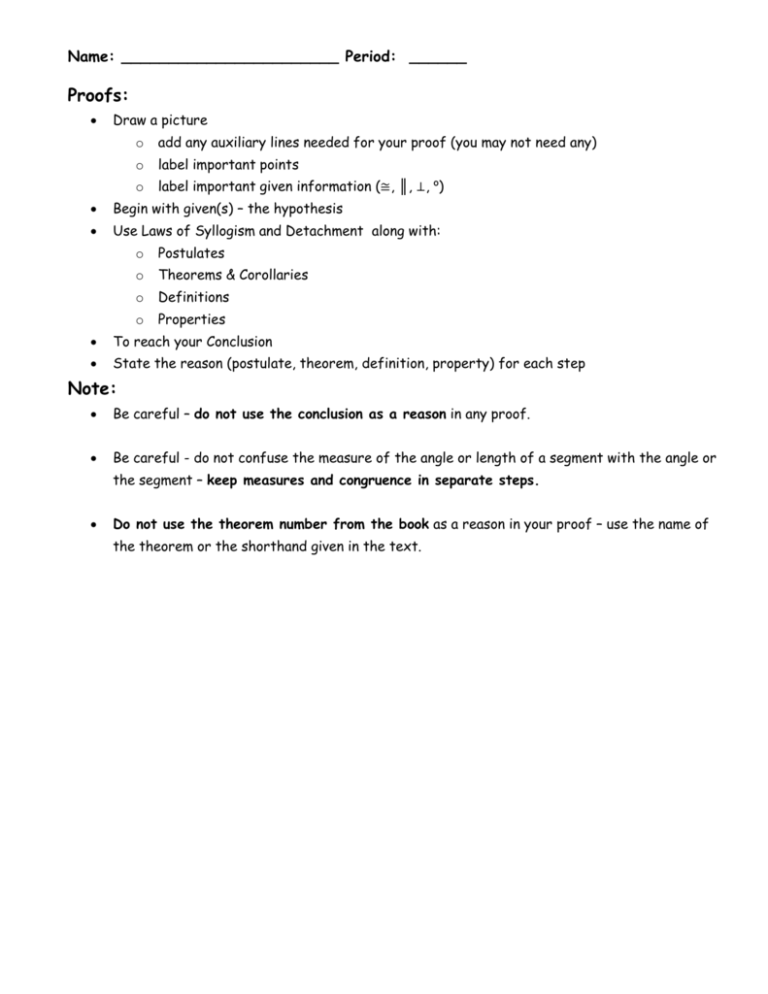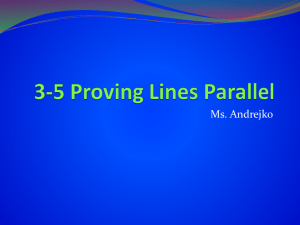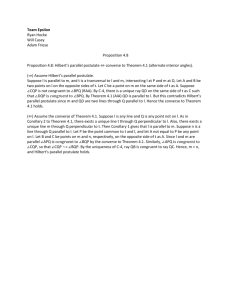File
advertisement

Name: _______________________ Period: ______ Proofs: Draw a picture o add any auxiliary lines needed for your proof (you may not need any) o label important points o label important given information (≅, ║, ⊥, º) Begin with given(s) – the hypothesis Use Laws of Syllogism and Detachment along with: o Postulates o Theorems & Corollaries o Definitions o Properties To reach your Conclusion State the reason (postulate, theorem, definition, property) for each step Note: Be careful – do not use the conclusion as a reason in any proof. Be careful - do not confuse the measure of the angle or length of a segment with the angle or the segment – keep measures and congruence in separate steps. Do not use the theorem number from the book as a reason in your proof – use the name of the theorem or the shorthand given in the text. The Basics: Term Name Diagram Point Line Plane Segment Ray Angle Postulate 1: Ruler Postulate – the points on a line can be put in 1-to-1 correspondence with ℝ. Postulate 2: Segment Addition Postulate Postulate 3: Protractor Postulate Postulate 4: Angle Addition Postulate Postulate 5: Through any 2 points there is exactly 1 line. Postulate 6: Postulate 7: If 2 lines intersect, they intersect in exactly 1 point. Postulate 8: Through any 3 non-collinear points there is exactly one plane containing them. Postulate 9: Postulate 10: If 2 points lie in a plane, the line containing those points lies in the plane. Postulate 11: If 2 planes intersect, they intersect in exactly 1 line. Reasoning and Proof- Chap 2 Conjecture: Hypothesis: Conclusion: Inductive Reasoning: Deductive Reasoning: Laws of Detachment and Syllogism are NOT to be used as a reason in a proof: Law of Detachment: Law of Syllogism: Reflexive Property of Congruence: Symmetric Property of Congruence: Transitive Property of Congruence: Linear Pair Theorem: Congruent Supplements Theorem: Right ∠ Congruence Theorem: Congruent Complements Theorem: Vertical ∠s Theorem: If 2 ≅ ∠s are supplementary, then each ∠ is a right ∠. Angles Corresponding Angles Postulate – 2 ∥ lines cut by transversal ⟹ corresponding ∠s are ≅. Alternate Interior Angles Theorem – 2 ∥ lines cut by transversal ⟹ alt int ∠s are ≅. Alternate Exterior Angles Theorem – 2 ∥ lines cut by transversal ⟹ alt ext ∠s are ≅. Same Side Interior Angles Theorem – 2 ∥ lines cut by transversal ⟹ same side int ∠s are supplementary. Parallel Postulate – Through a point 𝒫 not on a line ℓ there is exactly 1 line ∥ to ℓ. Converse of the Corresponding Angles Postulate Converse of the Alternate Interior Angles Theorem Converse of the Alternate Exterior Angles Theorem Converse of the Same Side Interior Angles Theorem 2 intersecting lines form a linear pair of ≅ ∠s ⇒ lines ⊥. Perpendicular Transversal Theorem Coplanar lines ⊥ to the same line ⇒ 2 lines ∥. Parallel Lines Theorem Perpendicular Lines Theorem Triangles Triangle Sum Theorem o Acute angles of a right ∆ are complementary o Each angle of an equiangular ∆ measures 60º Exterior Angle Theorem Third Angles Theorem SSS SAS ASA AAS HL CPCTC Isosceles Triangle Theorem Converse of Isosceles Triangle Theorem o Equilateral → Equiangular o Equiangular → Equilateral Perpendicular Bisector Theorem Converse of the Perpendicular Bisector Theorem Angle Bisector Theorem Converse of the Angle Bisector Theorem. Circumcenter Theorem Incenter Theorem Centroid Theorem Triangle Midsegment Theorem In ∆, larger ∠is opp. longer side. In ∆, longer side is opp. larger ∠. Triangle Inequality Theorem Hinge Theorem Converse of the Hinge Theorem Converse of the Pythagorean Theorem Pythagorean Inequalities Theorem 45º - 45º - 90º Triangle Theorem 30º - 60º - 90º Triangle Theorem Polygons Polygon ∠ Sum Theorem Polygon Exterior ∠ Sum Theorem Properties of Parallelograms: ⇒ opp. sides ≅ ⇒ opp. ∠s ≅ ⇒ consec. ∠s suppl. ⇒ diags. bisect each other Conditions for Parallelograms (Converses) Def: Both pairs opposite sides One pair opposites sides Both pairs opposite ∠s Thm: Quad with opp. sides ≅ ⇒ Thm: Quad with pair of opp sides ∥ and ≅ ⇒ Thm: Quad with opposite ∠𝑠 ≅ ⇒ Thm: Quad with ∠ supp. to cons. ∠𝑠 ≅ ⇒ One ∠ Thm: Quad with diags. bisecting each other ⇒ Diagonals Properties of Rectangles: Rect. ⇒ Rect. ⇒ diags. ≅ Conditions for Rectangles (Converses) Condition Def: Thm: Thm: with one rt. ∠ ⇒ rect. with diags. ≅ ⇒ rect. Example Properties of Rhombuses: Rhombus ⇒ Rhombus ⇒ diags. ⊥ Rhombus ⇒ each diag. bisects opp. ∠s Conditions for Rhombuses (Converses) Condition Def: Thm: with one pair cons. sides ≅ ⟹ Rhombus Thm: with diags. ┴ ⟹ Rhombus Thm: with diag. bisecting opp. ∠s ⟹ Rhombus Properties of Kites: (def) Kite – Kite ⇒ diags. ⊥ Kite ⇒ exactly one pair opp. ∠𝑠 ≅. Example Trapezoids: Isosc. trap. ⇒ base ∠𝑠 ≅. Trap. with pair base ≅ ∠𝑠 ⇒ isosc. trap. Isosc. trap ⇔ diags. ≅ Trapezoid Midsegment Theorem: Similarity Cross Product Property Properties of Proportions Similar Polygons Similar Polygons Definition Diagram AA Similarity SSS Similarity SAS Similarity Reflexive property of similarity Symmetric property of similarity Transitive property of similarity Triangle Proportionality Theorem Statements Converse of the Triangle Proportionality Theorem Two Transversal Proportionality Corollary Triangle Angle Bisector Theorem Proportional Perimeters and Areas Theorem Circles Tangent to a circle Tangent segments Minor arcs are congruent If one chord is a perpendicular bisector If a diameter of a circle is perpendicular to a chord In the same circle, or in congruent circles, two chords are congruent Measure of an Inscribed Angle If two inscribed angles of a circle intercept the same arc If a right triangle is inscribed in a circle A quadrilateral can be inscribed in a circle If a tangent and a chord intersect at a point on the circle Angles Inside the Circle Angles Outside the Circle Segments of Chords Theorem Segments of Secants Theorems Segments of Secants and Tangents Theorem DEFINITIONS TO KNOW: Angle(s) Interior Exterior Vertex Degree Acute Right Obtuse Angle Pairs: Adjacent Straight Complementary Supplementary Linear Pair Vertical Corresponding Alternate Interior Alternate Exterior Bisect/Bisector Circles Arcs Congruent Intercepted Minor Major Center Central Angle Chord Inscribed Angle Secant Semicircle Standard Equation of a Circle Tangent Collinear Conclusion Condition Conditional Statements Biconditional Converse Inverse Contrapositive Congruent Angles Polygons Segments Conjecture Contrapositive Converse Coordinate Coplanar Corollary Definition Diagonal Distance/length Endpoint Hypothesis Inverse Kite Line Pairs Parallel Intersecting Skew Midpoint Polygon Postulate Property Quadrilaterals Parallelogram Rectangle Rhombus Trapezoid Kite Similar Theorem Trapezoid Base Legs Base angles Triangles Isosceles Scalene Equilateral Equiangular Acute, Obtuse, Right







